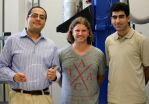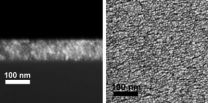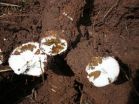(Press-News.org) CORVALLIS, Ore. – A survey of teachers from the United States and Canada found that one out of four educators who used live animals as part of their science curriculum released the organisms into the wild after they were done using them in the classroom.
Yet only 10 percent of those teachers participated in a planned release program, increasing the likelihood that the well-intentioned practice of using live organisms as a teaching tool may be contributing to invasive species problems.
The study was presented today (Aug. 7) in Portland at the national meeting of the Ecological Society of America.
"Live organisms are a critical element for learning and we don't want to imply that they should not be used in the classroom," said Sam Chan, an Oregon State University invasive species expert and a principal investigator on the study. "But some of our schools – and the biological supply houses that provide their organisms – are creating a potential new pathway for non-native species to become invasive.
"We need to work through the whole chain and educate both the teachers and suppliers about the potential damages – both environmental and economic – that invasive species may trigger," added Chan, a Sea Grant Extension specialist and former chair of the Oregon Invasive Species Council.
The study surveyed nearly 2,000 teachers in Florida, New York, Indiana, Illinois, Oregon, Washington, California, Connecticut, British Columbia and Ontario. Conducted primarily by Sea Grant researchers, it also included focus groups and interviews with teachers, curriculum specialists and biological supply house owners and managers.
The researchers found as many as 1,000 different organisms utilized by the teachers, and many frequently listed species were known or potential aquatic invasive species including elodea, crayfishes, amphibians, mosquito fish, red-eared slider turtles and other aquatic plants and snails.
Crayfish, Chan said, provide an interesting case study.
"Oregon teachers who have ordered crayfish that originate in the Pacific Northwest have found that their mortality is extremely high, so many have taken to ordering crayfish from distributors who get their supply from Louisiana," Chan said. "The problem is that we have no idea whether those crayfish may carry diseases or parasites that may be problematic if those animals are released into the wild here."
Funded by the National Oceanic and Atmospheric Administration, the study also pointed to the dilemma that teachers face over what to do with the animals after the curriculum section has been completed.
"Teachers are evenly split over the idea of euthanasia," Chan said. "In some cases, it may be the only option. We don't recommend what teachers would do, but suggest they consult a local veterinarian. Our goal as researchers is to make the teachers and biological supply houses aware that releasing organisms into the wild may cause problems and to think about using native species in lessons whenever possible."
One problem, Chan acknowledged, is that biological supply house managers don't see this as their issue. About 50 percent of the animals used by teachers came from pet stores or aquariums; the others from supply houses.
"More than one of them told us 'it isn't our job to educate the teachers,'" Chan said. "On the flip side, there were some who said they would be willing to work with us to try to provide more local organisms."
Chan and his colleagues say the project provides a rare opportunity to study an invasive species pathway along the entire chain, from the wholesaler to the release of organisms into the wild. Educating the teachers and the suppliers about invasive species issues is the first step toward changing behavior, the OSU researcher points out.
"Many of the teachers were mortified when we pointed out they may be exacerbating the invasive species problem," Chan said. "They want to be part of the solution, not part of the problem. But it is a complex issue. We don't want to discourage the use of live organisms in teaching because they can provide focus, enhance student interest, and foster responsibility and care.
"But there are consequences to using them and both teachers and suppliers should consider what will become of these organisms when the classroom lessons are over," he added.
### END
Study finds a new pathway for invasive species – science teachers
2012-08-08
ELSE PRESS RELEASES FROM THIS DATE:
Plain packaging of cigarettes encourages young smokers to heed health warnings
2012-08-08
New research published online in the scientific journal Addiction shows that plain packaging (requiring cigarettes to be packaged in standard packages without attractive designs and imagery) may help to draw the attention of some adolescent smokers to the health warnings on the package. If so, this may in turn deter young smokers from continuing to smoke.
Researchers asked eighty-seven teenage secondary school (high school) students from the city of Bristol, UK, to look at twenty images of cigarette packs on a computer screen for ten seconds each while a device tracked ...
Thinner diabetics face higher death rate
2012-08-08
CHICAGO --- American adults of a normal weight with new-onset diabetes die at a higher rate than overweight/obese adults with the same disease, according to a new Northwestern Medicine study.
The study, to be published in the Aug. 7 issue of JAMA, found that normal-weight participants experienced both significantly higher total and non-cardiovascular mortality than overweight/obese participants.
Normal-weight adults with type 2 diabetes have been understudied because those who typically develop the disease are overweight or obese. In this study about 10 percent of those ...
Coach could be key in helping stroke patients
2012-08-08
WINSTON-SALEM, N.C. – August 6, 2012 – When a stroke patient is discharged from the hospital, they often must cope with a new disability or lack of function, so changes in their medications or a new dosing prescription can be particularly confusing. This can lead the patient to overmedicate, take the wrong medication or skip medications entirely and can result in being readmitted to the hospital.
But a pilot study that is looking at a new discharge strategy and being led by researchers at Wake Forest Baptist Medical Center, indicates that phone calls and conversations ...
Using millions of years of cell evolution in the fight against cancer
2012-08-08
As the medical community continues to make positive strides in personalized cancer therapy, scientists know some dead ends are unavoidable. Drugs that target specific genes in cancerous cells are effective, but not all proteins are targetable. In fact, it has been estimated that as few as 10 to 15 percent of human proteins are potentially targetable by drugs. For this reason, Georgia Tech researchers are focusing on ways to fight cancer by attacking defective genes before they are able to make proteins.
Professor John McDonald is studying micro RNAs (miRNAs), a class ...
UCF nanoparticle discovery opens door for pharmaceuticals
2012-08-08
What a University of Central Florida student thought was a failed experiment has led to a serendipitous discovery hailed by some scientists as a potential game changer for the mass production of nanoparticles.
Soroush Shabahang, a graduate student in CREOL (The College of Optics & Photonics), made the finding that could ultimately change the way pharmaceuticals are produced and delivered.
The discovery was based on using heat to break up long, thin fibers into tiny, proportionally sized seeds, which have the capability to hold multiple types of materials locked in ...
New drug successfully halts fibrosis in animal model of liver disease
2012-08-08
A study published in the online journal Hepatology reports a potential new NADPH oxidase (NOX) inhibitor therapy for liver fibrosis, a scarring process associated with chronic liver disease that can lead to loss of liver function.
"While numerous studies have now demonstrated that advanced liver fibrosis in patients and in experimental rodent models is reversible, there is currently no effective therapy for patients," said principal investigator David A. Brenner, MD, vice chancellor for Health Sciences and dean of the School of Medicine at the University of California, ...
Chemists advance clear conductive thin films
2012-08-08
PROVIDENCE, R.I. [Brown University] — In a touch-screen display or a solar panel, any conductive overlay had better be clear. Engineers employ transparent thin films of indium tin oxide (ITO) for the job, but a high-tech material's properties are only half its resume. They must also be as cheap and easy to manufacture as possible. In a new study, researchers from Brown University and ATMI Inc. report the best-ever transparency and conductivity performance for an ITO made using a chemical solution, which is potentially the facile, low-cost method manufacturers want.
"Our ...
Diseased trees new source of climate gas
2012-08-08
Diseased trees in forests may be a significant new source of methane that causes climate change, according to researchers at the Yale School of Forestry & Environmental Studies in Geophysical Research Letters.
Sixty trees sampled at Yale Myers Forest in northeastern Connecticut contained concentrations of methane that were as high as 80,000 times ambient levels. Normal air concentrations are less than 2 parts per million, but the Yale researchers found average levels of 15,000 parts per million inside trees.
"These are flammable concentrations," said Kristofer Covey, ...
Researchers demonstrate control of devastating cassava virus in Africa
2012-08-08
ST. LOUIS, MO, August 7, 2012— An international research collaboration recently demonstrated progress in protecting cassava against cassava brown streak disease (CBSD), a serious virus disease, in a confined field trial in Uganda using an RNA interference technology. The field trial was planted in November 2010 following approval by the National Biosafety Committee of Uganda. The plants were harvested in November 2011 and results were published in the August 1, 2012 issue of the journal Molecular Plant Pathology . These results point researchers in the right direction ...
GEN reports on recent progress in Alzheimer's research
2012-08-08
New Rochelle, NY, August 7, 2012—The global market value of Alzheimer's disease therapeutics could soar to the $8 billion range once therapeutics are approved that actually change the course of the disease, reports Genetic Engineering & Biotechnology News (GEN). The current therapeutic market is valued at $3 to $4 billion, shared among drugs that temporarily delay disease progression or address the symptoms but do not alter the underlying disease, according to a recent issue of GEN.
"Despite all the research on amyloid plaques and neurofibrillary tangles there is still ...


